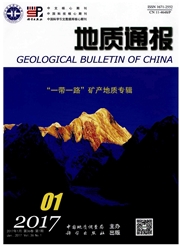

 中文摘要:
中文摘要:
额尔宾山花岗岩岩体位于南天山晚古生代侵入岩带,对该花岗岩进行锆石U-Pb定年获得296.1±1.8Ma的年龄,为早二叠世。岩石主量元素分析结果表明,该花岗岩的Si O2含量为66.96%~67.3%,富碱(Na2O+K2O=7.53%~7.97%),K2O/Na2O〉1(1.15~1.27),属高钾钙碱性系列岩石;Al2O3为15.56%~15.62%,Al2O3〉K2O+Na2O+Ca O,属于过铝型。岩石稀土元素配分模式呈现轻稀土元素(LREE)富集((La/Yb)N=27.03~30.62)、重稀土元素(HREE)亏损((LREE/HREE)=18.2~20.1)、具有中等程度的负Eu异常(δEu=0.64~0.68)。微量元素判别结果显示,其具有I-A型花岗岩过渡的特征。结合区域地质背景综合分析,初步认定该岩体可能形成于南天山同碰撞向后碰撞构造体制转换时期,据此可以推测南天山洋盆闭合时限至少应该在早二叠世以前。
 英文摘要:
英文摘要:
Erbeng plutons are located along the South Tianshan Late Paleozoic intrusive rock belts. LA-ICP-MS dating yielded a zir- con U-Pb age of296.1+1.8Ma (MSWD=0.05) , suggesting that this body was emplaced in the Early Permian. The granites from the Erbeng plutons are characterized by silica (66.96%-67.3%) and rich alkali (Na20+K20=7.53%-7.97%), obvious variation of K20/ Na20 (1.15~1.27) with the A/CNK being 0.99-1.03, suggesting that they are of weakly peraluminous and high-K calc-alkaline se- ries. They are enriched in LREE ((La/Yb)N=27.03-30.62) and depleted in HREE ((LREE/HREE)=18.2-20.1). They have negative Eu anomaly ( 8 Eu=0.64-0.68), with slightly right-dipping V-type chondrite-normalized rare earth element patterns. Geochemically, they show transition features from I to A type granites. This age, together with their geochemical signatures of I-A type granite and the zircon saturation temperatures of 819-837℃, indicates that this body was emplaced at a transition stage from syncollision to post-collision. From the zircon U-Pb ages combined with regional geological background, the authors infer that the southern Tian- shan Ocean might have been closed at least before the beginning of the Early Permian.
 同期刊论文项目
同期刊论文项目
 同项目期刊论文
同项目期刊论文
 期刊信息
期刊信息
